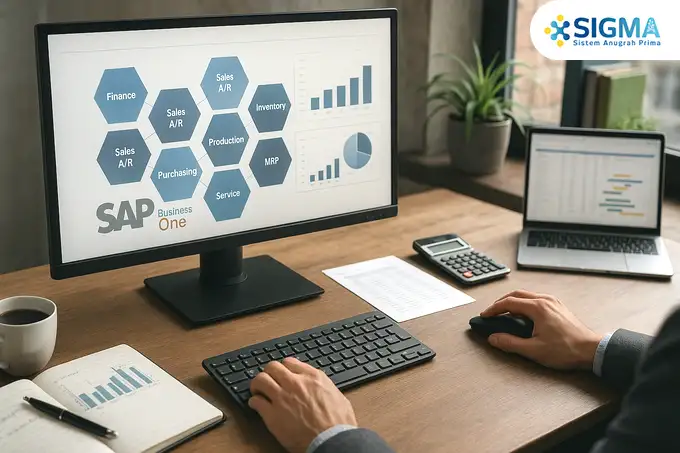Why SAP Business One Modules Are the Heart of Modern Business Solutions
Let’s start with a common truth. Many SMEs still wrestle with scattered spreadsheets, standalone accounting software, or even manual entries scribbled in ledgers. Data is fragmented. Departments operate in silos. The result? Delayed processes, poor decision-making, and lost information along the way.
SAP Business One breaks this vicious cycle. It’s not just an ERP—it’s a comprehensive, integrated business solution meticulously crafted for SMEs.
Its strength lies in its modular architecture. Each module is a customizable building block, tailored to suit the unique needs of your enterprise.
This article will help you understand:
- What a module is within SAP Business One
- The standard modules available
- The function of each module and the specific pain points they address
- How they work together in a unified system
- Steps to begin a successful implementation
What Is a Module in the Context of SAP Business One?
Don’t think of “modules” as academic courses. In SAP Business One, a module is a functional unit—each representing a distinct aspect of your operations.
For example:
- Financials – for accounting
- Inventory – for stock management
- Sales – for sales processes
- Purchasing – for procurement
These modules are functionally distinct, yet they operate harmoniously within a single ecosystem, powered by one unified database. Unlike disjointed applications, SAP Business One is engineered for cross-departmental collaboration with real-time visibility.
Exploring the Standard Modules in SAP Business One
Many feel overwhelmed when first encountering the list of available modules. Relax—there’s no need to use them all at once. The key is understanding what’s available and what you truly need.
Here’s a concise overview of SAP Business One’s standard modules and their respective functions:
- Administration – System setup, user licenses, and initial configuration.
- Financials – General ledger, budgeting, and financial reporting.
- Sales – A/R – Quotations, sales orders, deliveries, and invoicing.
- Purchasing – A/P – Purchase requests, orders, goods receipts, vendor invoices.
- Business Partners – Customer and vendor data, contacts, and financial info.
- Banking – Payments, collections, and bank reconciliation.
- Inventory – Stock management, warehouse tracking, batch/serial numbers.
- Production – Bill of Materials (BOM), work orders, manufacturing processes.
- MRP – Material requirements planning.
- Service – Service ticket tracking and contract management.
- Human Resources – Employee data, attendance, and payroll (based on localization).
- Project Management – Project oversight, budgeting, and timelines.
- Reporting – Dashboards, queries, and operational reports.
How Each Module Solves Your Specific Business Pain Points
Let’s get into the technical side. Below are real-world problems SMEs face—and how specific modules provide tangible solutions.
📊 Financial Module: Managing Cash Flow and Reporting
- The Issue: Difficulty generating financial reports, slow bank reconciliation, uncollected receivables.
- The Solution: With tools like the General Ledger, AR/AP, and Banking modules, every transaction is automatically recorded. Daily bank reconciliation and real-time financial reports become seamless.
🛒 Sales Module: From Prospect to Invoice
- The Issue: Lost orders, missing records, delayed invoicing.
- The Solution: From quotations to sales orders, deliveries, and invoicing—everything is just a click away. No data re-entry required, and every customer transaction is historically logged.
🏭 Inventory Module: Hassle-Free Warehouse Management
- The Issue: Overstocked warehouses, dead inventory, out-of-stock crises.
- The Solution: Warehouse management features, batch/serial tracking, and real-time stock valuation empower you to identify fast-moving vs. stagnant items.
📦 Purchasing Module: Smarter Procurement
- The Issue: Over-purchasing or raw material shortages.
- The Solution: Forecasting, purchase requests, and PO approvals are streamlined. MRP features enable automated materials planning.
How SAP Business One Modules Work in Harmony
Now let’s focus on integration—an often overlooked yet crucial aspect. Many inferior ERP systems only appear connected, while still relying heavily on manual cross-department entries.
SAP Business One is built on a centralized database. This means:
- Entries in the Sales module automatically update Inventory.
- Purchase transactions flow directly into Financials and Banking.
- Everything is interconnected—no duplication of work.
A typical workflow:
- A Sales Order is created ➜
- Goods are delivered ➜
- An invoice is issued ➜
- Accounts receivable is updated ➜
- Financial reports are instantly refreshed.
Getting Started: A Practical Guide to Module Adoption
Don’t be daunted. Mastery of every module isn’t a prerequisite. Begin with those that impact your daily operations the most.
Practical steps:
- Identify the most problematic business processes.
- Start with the relevant modules (e.g., Inventory or Finance).
- Conduct internal workshops with SIGMA’s guidance.
- Plan a phased implementation.
- Train, simulate, and then go live.
SIGMA offers hands-on training, technical consultation, and full support throughout the transition. Your team will never have to navigate the learning curve alone.
Conclusion: Why SAP Business One Modules Are the Key to Your Business Growth
We’ve covered a great deal—let’s wrap it up.
SAP Business One is more than just an ERP. It’s a synergistic, modular, and scalable system for Indonesian SMEs. From finance, purchasing, and sales to inventory, production, and reporting—everything operates under one roof. No more duplicate work, no more missing data.
Here’s what you’ll gain:
- Streamlined processes
- Accurate, centralized data
- Faster decision-making
- Full operational visibility
🚀 Ready to elevate your business with the transformative power of SAP Business One modules?
Don’t wait. Contact PT. Sistem Anugrah Prima (SIGMA)—your trusted partner—for an in-depth consultation and the next step on your digital transformation journey.


